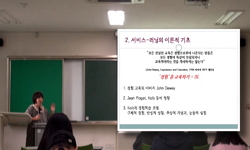본 연구의 목적은 학습공동체 프로그램에 참여한 대학생의 경험분석을 바탕으로 일반집단과 우수집단 간 참여역량 비교를 통해 학습공동체 성공요인을 도출하고, 학습공동체 효과 제고를 ...
http://chineseinput.net/에서 pinyin(병음)방식으로 중국어를 변환할 수 있습니다.
변환된 중국어를 복사하여 사용하시면 됩니다.
- 中文 을 입력하시려면 zhongwen을 입력하시고 space를누르시면됩니다.
- 北京 을 입력하시려면 beijing을 입력하시고 space를 누르시면 됩니다.

대학 학습공동체 활동성과에 따른 참여역량 분석 : 일반집단과 우수집단 간 비교를 중심으로 = An Analysis of Competency among Learning Community Participants Depending on their Performance: Focusing on the Comparisons between High and Ordinary Performers
한글로보기https://www.riss.kr/link?id=A108127830
- 저자
- 발행기관
- 학술지명
- 권호사항
-
발행연도
2022
-
작성언어
-
- 주제어
-
KDC
370
-
등재정보
KCI등재
-
자료형태
학술저널
-
수록면
373-389(17쪽)
- 제공처
-
0
상세조회 -
0
다운로드
부가정보
국문 초록 (Abstract)
본 연구의 목적은 학습공동체 프로그램에 참여한 대학생의 경험분석을 바탕으로 일반집단과 우수집단 간 참여역량 비교를 통해 학습공동체 성공요인을 도출하고, 학습공동체 효과 제고를 위한 지원방안을 제안하는 것이다. 이를 위해 학습공동체 활동에 참여한 학생 111명을 대상으로 성찰일지를 수집하고, 내용분석 방법을 통해 이들의 학습경험을 분석하였다. 그 결과 첫째, 두 집단의 반응빈도를 비교한 결과, 전체 54개 문항 중 35개 문항에서 우수 집단의 반응빈도가 상대적으로 높게 나타났으며, 7개 문항에서 일반집단의 반응빈도가 상대적으로 높았다. 둘째, 학습공동체 활동성과에 따른 참여역량을 비교한 결과, 우수집단은 표현능력, 자기성찰능력, 문제해결능력, 협업능력, 집단운영능력, 학습목표설정 순으로 높은 반응빈도를 보였으며, 일반집단은 문제해결능력, 집단운영능력, 표현능력, 협업능력 순으로 높은 반응빈도를 보였다. 셋째, 효과적인 학습공동체 운영을 위한 성공요인은 ‘지속강화’, ‘중점지원’, ‘추가지원’ 참여역량으로 구분하여 총 6개(문제해결을 위한 다각적 접근, 공동체 운영계획 수립과 공유, 자유롭고 명확한 개인 의사표현, 공동의 목표달성을 위한 과업수행, 자기이해를 통한 자기성장, 구체적인 학습목표 설정과 일정 관리)로 도출되었다. 마지막으로 이러한 연구결과를 바탕으로 효과적인 학습공동체 운영을 위한 시사점과 추후 연구를 제언하였다.
다국어 초록 (Multilingual Abstract)
This study aimed to derive specific critical success factors using comparison analysis between a high performing group and an ordinary performing group who participated in a learning community and to propose support methods enhancing the effects of le...
This study aimed to derive specific critical success factors using comparison analysis between a high performing group and an ordinary performing group who participated in a learning community and to propose support methods enhancing the effects of learning communities. For these purposes, the data from the reflective journals written by 111 participants were categorized according to a matrix designed for the content analysis. The main study results can be summarized as below. First, the comparison data on the response frequency of the two groups revealed that the high performing group responded more frequently than the other group in 35 out of 54 items and that the ordinary group responded relatively more frequency in 7 items. Second, the results from comparing the competencies of the two groups showed that the high group’s frequency of participants’competencies were different from that of the other group. The factors more frequently commented by the high performers are listed as follows: expression, self-reflection, problem solving, collaboration, group operation, and learning goal-setting. According to the data on the other group, the factors more frequently used were problem solving, group operation, expression, and collaboration. Third, in order to increase the effectiveness of any given learning community, the six critical success factors namely, a multifaceted approach for problem-solving, planning and sharing operation plans, a free and clear expression of oneself, task performance for achieving common goals, self-growth from self-understanding, and specified goal-setting and scheduling, are classified by the following three dimensions of continuous reinforcement, prior support, and additional support. In conclusion, implications for effective learning communities and suggestions for following studies were discussed.
목차 (Table of Contents)
- 1. 서론 2. 이론적 배경 3. 연구방법 4. 연구결과 5. 논의 및 결론
- 1. 서론 2. 이론적 배경 3. 연구방법 4. 연구결과 5. 논의 및 결론
동일학술지(권/호) 다른 논문
-
- 한국교양교육학회
- 손종현(Son, Jong-Hyun)
- 2022
- KCI등재
-
대학 교양교육 비대면 수업의 대학생 직업기초능력 자기평가 성과분석 연구
- 한국교양교육학회
- 김순남(Kim, Soon Nam)
- 2022
- KCI등재
-
타 대학 교류 경험에 대한 대학생의 인식 : 대학 연합 비교과 프로그램 사례
- 한국교양교육학회
- 한송이(Han, Song Ie)
- 2022
- KCI등재
-
비대면 코칭 기반 대학 비교과 프로그램 개발 및 효과성 : S여자대학교를 중심으로
- 한국교양교육학회
- 김경아(Kim, Kyoung A)
- 2022
- KCI등재
분석정보
연관 공개강의(KOCW)
-

글로벌 인재포럼 2007: 창의적인 인재 관리의 핵심 성공요인
글로벌 인재포럼 Franz Cremer, Kent Lockhart, Richard A. Kleinert, Scott G. Drach -

Building a Learning Community with ICT
Teachers TV Teachers TV -

Learning to Cook at Oathall Community College
Teachers TV Teachers TV -

지역사회를 기반으로 하는 평생학습의 동향과 과제 새로운 동향과 패러다임
국가평생교육진흥원 고바야시 분진, 알레스테어 클라크, 그렉 퍼트, 박인종, 사사이 히로미 -

슈바이처 프로젝트
루터대학교 이지성




 KCI
KCI 스콜라
스콜라

